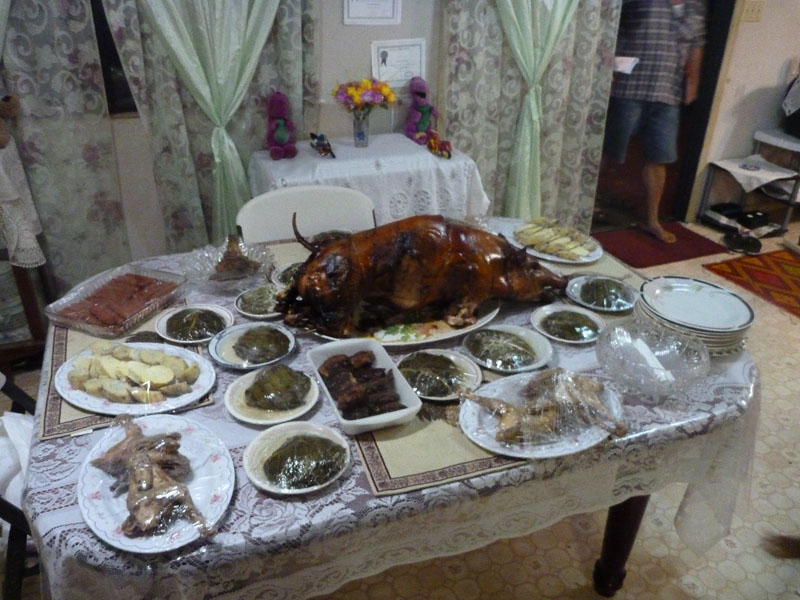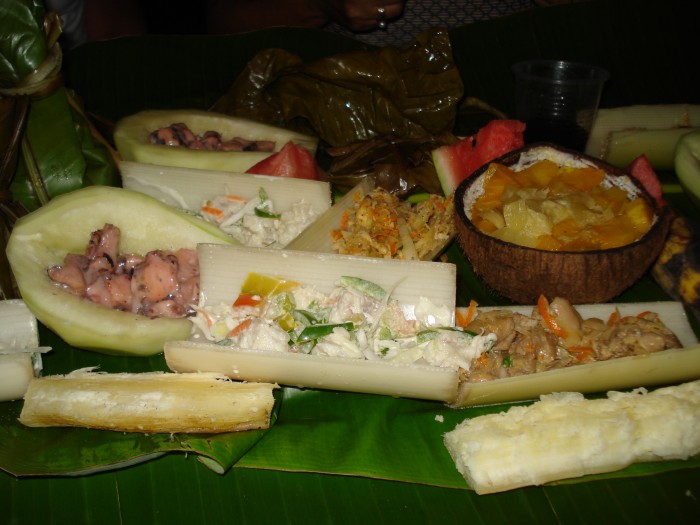Guest Post by Ruth Elayne Kongaika
My husband accepted a teaching position, and our new home was at Liahona High School in Tonga. The roads were paved, and there were even sidewalks (unlike neighboring villages). The school was in the middle, with the faculty houses flanking it on both sides. At the rear of the school, there was a large farm where they raised cows and pigs. Roosters and chickens ran wild, and they also raised a vegetable garden. The students of Liahona High School had to spend part of each day working on the plantation or farm to help pay for their tuition and food.
My husband’s parents worked as dorm parents for the girl’s living on campus. We waded through water up to our knees to get to their little apartment. It was the first time I had met my mother-in-law. I briefly met my father-in-law when he had visited the mainland United States. This was the first time both of them had met their little granddaughter, and they instantly fell in love with her. They were so welcoming, and I could see that they were preparing a fine feast for us.
 While they were cooking, we were invited to take a rest, which was much needed after the long flight. My husband and I took a nap, while our daughter enjoyed getting to know her grandparents and many cousins. When I awoke, I saw a huge beetle (about two inches long) right in front of my face. There was a flashlight, with a large lamp nearby. I grabbed it, and put it right on top of the beetle, so I could show it to my husband when he arose. When he finally opened his eyes, I proudly picked up the flashlight to reveal what I thought was a rare exotic beetle. He just laughed, and informed me that it was just a cockroach, and that they were all over in Tonga. I was mortified! In all my growing up years, I had never seen a cockroach, but had heard that wherever they lived, it was filthy! Later, I realized they thrived in Tonga, because of the warm moist climate.
While they were cooking, we were invited to take a rest, which was much needed after the long flight. My husband and I took a nap, while our daughter enjoyed getting to know her grandparents and many cousins. When I awoke, I saw a huge beetle (about two inches long) right in front of my face. There was a flashlight, with a large lamp nearby. I grabbed it, and put it right on top of the beetle, so I could show it to my husband when he arose. When he finally opened his eyes, I proudly picked up the flashlight to reveal what I thought was a rare exotic beetle. He just laughed, and informed me that it was just a cockroach, and that they were all over in Tonga. I was mortified! In all my growing up years, I had never seen a cockroach, but had heard that wherever they lived, it was filthy! Later, I realized they thrived in Tonga, because of the warm moist climate.
 After the buggy shock wore off, I looked down at my ankles and realized that they were swollen and red. They felt very itchy. There were a few fat mosquitos swarming around that were filled with my blood. Needless to say, I was not too fond of the “wild life” in Tonga. I later experienced spiders as huge as my hand (they won’t harm you, I was told), centipedes that were a foot long (they will harm you), fleas (to which I found I was allergic), bees, hornets, coconut beetles, walking sticks, plenty of lizards and other creatures. At least there are no snakes in Tonga.
After the buggy shock wore off, I looked down at my ankles and realized that they were swollen and red. They felt very itchy. There were a few fat mosquitos swarming around that were filled with my blood. Needless to say, I was not too fond of the “wild life” in Tonga. I later experienced spiders as huge as my hand (they won’t harm you, I was told), centipedes that were a foot long (they will harm you), fleas (to which I found I was allergic), bees, hornets, coconut beetles, walking sticks, plenty of lizards and other creatures. At least there are no snakes in Tonga.
So after my creep-crawly education, we were taken to a table laden with all manner of foods, which I had never laid my eyes on. There were root crops, including taro, ‘ufi (yam), manioke (tapioca), and kumala (sweet potato). I did my best to try everything, and I particularly enjoyed the kumala. There were also tropical fruits including mangos, pineapples, guava, watermelon, passion fruit, lychee, and lesi (papaya).
Most Tongans love mutton, and their favorite is mutton flaps (because they are inexpensive and have plenty of ngako or fat on them). They wrapped mutton flaps in taro leaves, added onions and coconut milk, and baked it. Yummy! They also served New Zealand sausages, chicken, fish and beef. A Tongan feast must have several meats. Often they will have a suckling pig. To top it off, we were served trifle, an island favorite. I was stuffed! I discovered that food is the ultimate gift, and very important in Tonga.
Ruth Elayne Kongaika was raised in the mainland, USA, but has been living in the South Pacific for the past forty years. She enjoys trying to capture the beauty and wonder of the islands through her photography, painting and writing. She has a blog which shares some of her art and favorite subjects at:
email: kongaikr@byuh.edu












